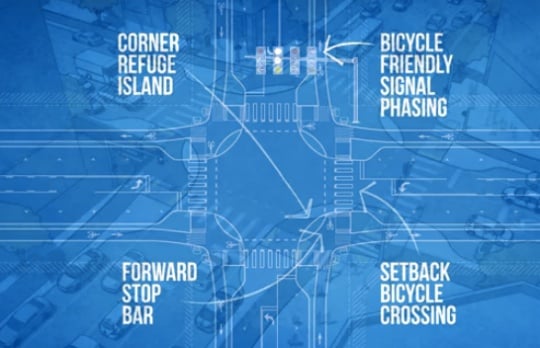Portland-based urban planner and designer Nick Falbo’s latest project aims to expand the benefits of protected bike lanes — places where people can ride with physical separation from auto traffic — all the way to intersections. Falbo calls them “protected intersections” and he’s launched a website and new animated video to help spread the idea.
The problem with protected bike lane (a.k.a. cycle track) designs in America is that they disappear at intersections. The favorite treatment of U.S. planners has been to create “mixing zones” where people in cars and people on bikes share the lane just prior to the corner. This design creates a weak link in the bikeway right where it should be its strongest. In contrast, cycle tracks in Dutch (and other) cities have dedicated space for cycling all the way to the corner and then bike-specific signals to get riders through safely.
With his protected intersections for bicyclists, Falbo is trying to translate that Dutch design into an American context. As you can see in the image below, there are four key elements to the design: a corner refuge island, bicycle-friendly signal phasing, a forward stop bar, and a setback bicycle crossing.

In an email to the Active Right of Way list this morning, Falbo said, “I hope to hit a few conferences this year pitching the these elements to whoever will listen.”
While he’s obviously enthused about the benefits of this design and committed to moving this idea forward, Falbo acknowledges there are some major challenges to overcome like large truck movements, auto capacity impacts, and how to make the design work well for people who walk and/or use a mobility device.
Falbo intends to tackle these challenges and post updates on his design to ProtectedIntersection.com, which he hopes will, “develop into a clearinghouse for exploration, examples, images, references related to the Protected Intersection design concept.”


